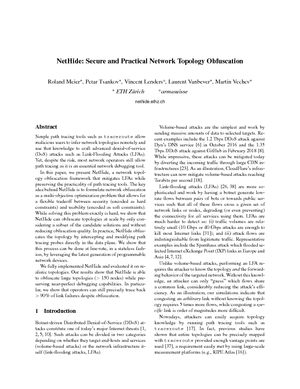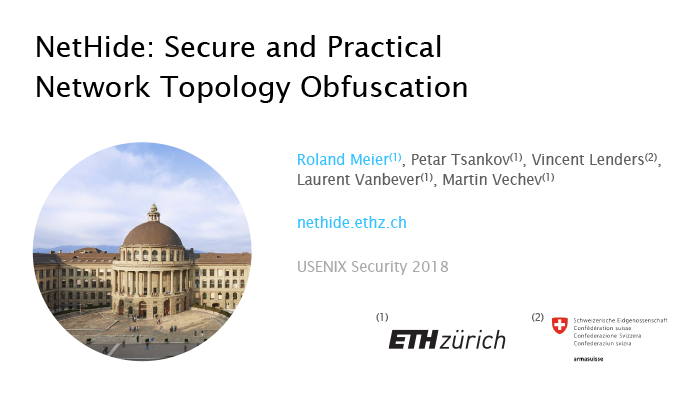NetHide: Secure and Practical
Network Topology Obfuscation
NetHide obfuscates network topologies in order to mitigate Link-Flooding Attacks (LFAs) while preserving the practicality of path tracing tools. The key idea behind NetHide is to formulate network obfuscation as a multi-objective optimization problem that allows for a flexible tradeoff between security (encoded as hard constraints) and usability (encoded as soft constraints). While solving this problem exactly is hard, we show that NetHide can obfuscate topologies at scale by only considering a subset of the candidate solutions and without reducing obfuscation quality. In practice, NetHide obfuscates the topology by intercepting and modifying path tracing probes directly in the data plane. We show that this process can be done at line-rate, in a stateless fashion, by leveraging the latest generation of programmable network devices.
We fully implemented NetHide and evaluated it on realistic topologies. Our results show that NetHide is able to obfuscate large topologies (> 150 nodes) while preserving near-perfect debugging capabilities. In particular, we show that operators can still precisely trace back >90% of link failures despite obfuscation.
Overview
NetHide operates in two steps: First, it computes a secure and usable virtual topology; and second, it deploys the obfuscated topology in the physical network.
NetHide produces an obfuscated virtual topology which: (i) prevents the attacker(s) from determining a set of flows to congest any link; while (ii) still allowing non-malicious users to perform network diagnosis. A key insight behind NetHide is to formulate this task as a multi-objective optimization problem that allows for a flexible tradeoff between security and usability of the virtual topology.
NetHide pre-computes a random set of secure candidate solutions and, computes the usefulness of each of them and selects the one with maximal usefulness.
NetHide obfuscates the topology at runtime by modifying tracing packets (e.g. packets sent by traceroute).
NetHide intercepts and processes such packets without impact on the network performance, directly in the data plane, by leveraging programmable network devices. Specifically, NetHide intercepts and possibly alters tracing packets at the edge of the network before sending them to the pretended destination in the physical network. That way, NetHide ensures that tracing packets traverse the corresponding physical links, and preserves the utility of traceroute-like tools.
Publications
NetHide: Secure and Practical Network Topology Obfuscation
Roland Meier, Petar Tsankov, Vincent Lenders, Laurent Vanbever, Martin Vechev
USENIX Security 2018. Baltimore, MD, USA (August 2018).
Simple path tracing tools such as traceroute allow malicious users to infer network topologies remotely and use that knowledge to craft advanced denial-of-service (DoS) attacks such as Link-Flooding Attacks (LFAs). Yet, despite the risk, most network operators still allow path tracing as it is an essential network debugging tool.
In this paper, we present NetHide, a network topology obfuscation framework that mitigates LFAs while preserving the practicality of path tracing tools. The key idea behind NetHide is to formulate network obfuscation as a multi-objective optimization problem that allows for a flexible tradeoff between security (encoded as hard constraints) and usability (encoded as soft constraints). While solving this problem exactly is hard, we show that NetHide can obfuscate topologies at scale by only considering a subset of the candidate solutions and without reducing obfuscation quality. In practice, NetHide obfuscates the topology by intercepting and modifying path tracing probes directly in the data plane. We show that this process can be done at line-rate, in a stateless fashion, by leveraging the latest generation of programmable network devices.
We fully implemented NetHide and evaluated it on realistic topologies. Our results show that NetHide is able to obfuscate large topologies (> 150 nodes) while preserving near-perfect debugging capabilities. In particular, we show that operators can still precisely trace back >90% of link failures despite obfuscation.
Presentations
NetHide: Secure and Practical Network Topology Obfuscation
Roland Meier
USENIX Security 2018. Baltimore, MD, USA (August 2018).






